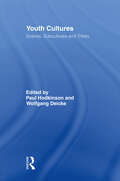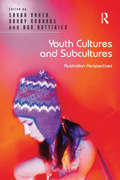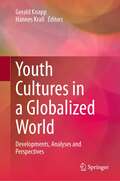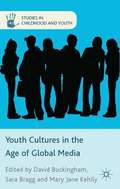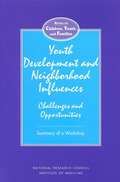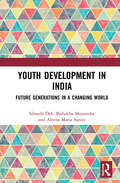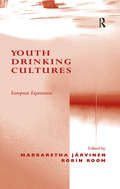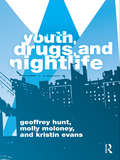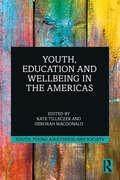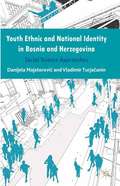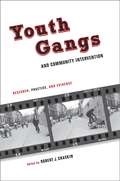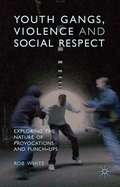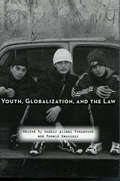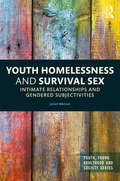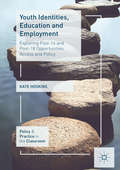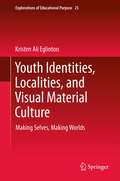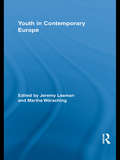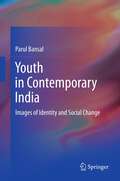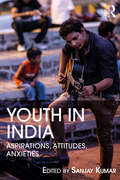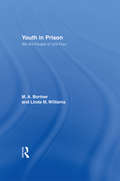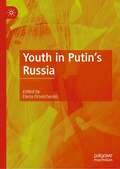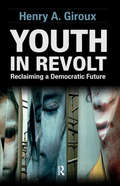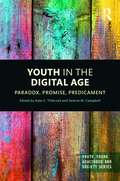- Table View
- List View
Youth Cultures: Scenes, Subcultures and Tribes (Routledge Advances in Sociology #10)
by Paul Hodkinson Wolfgang DeickeYouth Cultures offers a comprehensive outline of youth cultural studies in the twenty-first century, with reference to a range of new research case studies. Featuring both well known and emerging scholars from the UK, the US and mainland Europe, the book addresses core theoretical and methodological developments before going on to examine key substantive themes in the study of young people's identities and lifestyles. These include questions of commerce, power and politics, issues of gender and ethnicity, uses of place and space and impacts of new media and communications. Simultaneously offering an accessible introduction and a range of new contributions to the subject area, Youth Cultures will appeal to both students and academics within a range of disciplines, including sociology, media and cultural studies, youth studies and popular music studies.
Youth Cultures and Subcultures: Australian Perspectives
by Brady Robards Sarah BakerThis volume critically examines ’subculture’ in a variety of Australian contexts, exploring the ways in which the terrain of youth cultures and subcultures has changed over the past two decades and considering whether ’subculture’ still works as a viable conceptual framework for studying youth culture. Richly illustrated with concrete case studies, the book is thematically organised into four sections addressing i) theoretical concerns and global debates over the continued usefulness of subculture as a concept; ii) the important place of ’belonging’ in subcultural experience and the ways in which belonging is played out across an array of youth cultures; iii) the gendered experiences of young men and women and their ways of navigating subcultural participation; and iv) the ethical and methodological considerations that arise in relation to researching and teaching youth culture and subculture. Bringing together the latest interdisciplinary research to combine theoretical considerations with recent empirical studies of subcultural experience, Youth Cultures and Subcultures will appeal to scholars and students across the social sciences.
Youth Cultures in a Globalized World: Developments, Analyses and Perspectives
by Hannes Krall Gerald KnappThis book examines the relation between the phenomenon of globalization, changes in the lifeworld of young people and the development of specific youth cultures. It explores the social, political, economic and cultural impact of globalization on young people. Growing diversity in their lifeworlds, technological development, migration and the ubiquity of digital communication and representation of the world open up new forms of self-representation, networking and political expression, which are described and discussed in the book. Other topics are the impact of globalization on work and economy, global environmental issues such as climate change, political movements which put “nationalism first”, change of youth`s values and the significance of body, gender and beauty. The book highlights the challenges of young people in modern life, as well as the way in which they express themselves and engage in society – in culture, politics, work and social life.
Youth Cultures in the Age of Global Media
by David Buckingham Sara Bragg Mary Jane KehilyThis book explores the impact of globalisation and new technologies on youth cultures around the world, from the Birmingham School to the youthscapes of South Korea. In a timely reappraisal of youth cultures in contemporary times, this collection profiles the best of new research in youth studies written by leading scholars in the field.
Youth Development and Neighborhood Influences: Challenges and Opportunities Summary of a Workshop
by Committee on Youth DevelopmentA report on Youth Development and Neighborhood Influences
Youth Development in India: Future Generations in a Changing World
by Sibnath Deb Bishakha Majumdar Aleena Maria SunnyThis book provides a comprehensive understanding of youth development and protection in the Indian context. It reviews the demographic and socio-economic background and future prospects of Indian youth. The book discusses the role of family and culture in the upbringing and development of youth, changing political and socio-economic situations, and the influence of parents and teachers in shaping the future of the youth. The book highlights the nature of adversities faced by children and youth and the subsequent impact on their mental health and well-being. It also examines the efficacy of various skill development programmes and national and international policies designed for the youth. The book will be of interest to students, teachers, and researchers of population sciences, population studies, psychology, childhood studies, development studies, sociology, and youth studies. It will also be of interest to policymakers and NGOs working with children and youth.
Youth Drinking Cultures: European Experiences
by Margaretha Järvinen Robin RoomHow can 'binge drinking' be explained and understood? Is alcohol consumption related to the particular cultural characteristics of some European countries? Should heavy drinking cultures be seen as a mainstream youth phenomenon or as marginal - and is this different in different countries? A team of leading researchers addresses these questions and more in their analysis of the alcohol consumption patterns of European young people. Alcohol consumption is an important marker of transition from childhood to early adulthood, yet the timing, intensity and purpose of adolescent drinking varies dramatically between countries. The contributors provide cross-national comparisons to investigate how drinking behaviour varies, examining factors such as gender, societal context and family socio-economic backgrounds. Youth Drinking Cultures offers a comprehensive set of perspectives on adolescent drinking in Europe. In linking issues around social identity and the life-course with a highly topical area of media and policy concern, the book will be of great value to sociology and social policy scholars, especially youth researchers, and also to professionals working with young people.
Youth, Drugs, and Nightlife
by Geoffrey Hunt Molly Moloney Kristin EvansYouth, Drugs, and Night Life examines the relationships between the electronic dance scene and drug use for young ravers and clubbers today. Based on over 300 interviews with ravers, DJ’s and promoters, Hunt, Moloney, and Evans examine the different social groupings that make up the scene. The authors explore the accomplishment of gender, sexuality, and Asian American ethnic identity and critically analyze the negotiation of risk and pleasure within the world of raves and dance clubs. We learn about young ravers and clubbers’ frustrations with recent attempts to control clubs and raves and their skepticism about official pronouncements on the dangers of ecstasy and other drugs, in this book that pivots between the local, the national, and the global in its approach.
Youth, Education and Wellbeing in the Americas (Youth, Young Adulthood and Society)
by Kate C. Tilleczek Deborah MacDonaldThis book explores ways in which education supports or negates the wellbeing and rights of young people in/from the Americas. It shows how young people diagnose problems and propose important new directions for education. A collective chronicle from researchers working alongside young people in Chile, Dominican Republic, Guatemala, Honduras, Trinidad & Tobago, Jamaica, and the Caribbean and Latin American diaspora in Canada, the authors embrace the work in terms of justice: intergenerational, racial, cultural, and ecological with/by/for various groups of young people. This book delves into the wide gap between the expressed rights of young people in the United Nations Convention on the Rights of the Child and the ways in which education operates. In so doing it examines the entrenched colonial legacies which persist including systemic racism, flabby curriculum, hyper-surveillance and broken promises for care and human relationships needed to support youth. The resourceful young people shown here—who identify as Latin American, Black, Indigenous and/or diasporic—are diagnosing and negotiating these injustices in revolutionary moves for education. Teachers, parents, communities and youth themselves could learn from these critical, transformative and anticolonial youthful pedagogies for being with education. This book will appeal to scholars, students, policymakers and practitioners in the areas of youth studies, education, social justice, sociology, human rights, wellbeing and social work.
Youth Ethnic and National Identity in Bosnia and Herzegovina
by Danijela Majstorovic Vladimir TurjacaninYouth Ethnic and National Identity in Bosnia and Herzegovina is an interdisciplinary effort to position and describe the contested nature of state and ethnic identity among youth in Bosnia and Herzegovina by providing empirical, first-hand evidence on identity structure and the subsequent implications for inter-group relations.
Youth Gangs and Community Intervention: Research, Practice, and Evidence
by Chaskin Robert J. Ed.Although a range of program and policy responses to youth gangs exist, most are largely based on suppression, implemented by the police or other criminal justice agencies. Less attention and fewer resources have been directed to prevention and intervention strategies that draw on the participation of community organizations, schools, and social service agencies in the neighborhoods in which gangs operate. Also underemphasized is the importance of integrating such approaches at the local level. In this volume, leading researchers discuss effective intervention among youth gangs, focusing on the ideas behind, approaches to, and evidence about the effectiveness of community-based, youth gang interventions. Treating community as a crucial unit of analysis and action, these essays reorient our understanding of gangs and the measures undertaken to defeat them. They emphasize the importance of community, both as a context that shapes opportunity and as a resource that promotes positive youth engagement. Covering key themes and debates, this book explores the role of social capital and collective efficacy in informing youth gang intervention and evaluation, the importance of focusing on youth development within the context of community opportunities and pressures, and the possibilities of better linking research, policy, and practice when responding to youth gangs, among other critical issues.
Youth Gangs, Violence and Social Respect
by Rob WhiteThis is the first book dedicated to Australian youth gangs, exploring the subtleties and nuances of street life for young men and their quest for social respect. It focuses specifically on group violence and the ways in which the 'gang' provides a forum for the expression of this violence. White argues that what happens on the street demands a holistic analysis which takes into account the interrelationships between class circumstance, masculinity, race and ethnicity. Gangs and gang violence are thus 'made' in the crucible of specific histories, specific neighbourhoods and specific social contexts. Based upon many years of research, and drawing upon the theoretical insights of international literature in this area, this book provides a sustained analysis and portrayal of youthviolence and youth gangs – one that includes and highlights the voices and viewpoints of the young people themselves.
Youth, Globalization, and the Law
by Sudhir Venkatesh Ronald KassimirThis book addresses the impact of globalization on the lives of youth, focusing on the role of legal institutions and discourses. As practices and ideas travel the globe--such as the promotion and transmission of zero tolerance and retributive justice programs, the near ubiquitous acceptance of the UN Convention on the Rights of the Child, and the transnational migration of street gangs--the legal arena is being transformed. The essays in this book offer case studies and in-depth analyses, spanning diverse settings including courts and prisons, inner-city streets, international human rights initiatives, newspaper offices, local youth organizations, and the United Nations. Drawing on everyday social practices, each chapter adds clarity to our current understanding of the ways in which ideas and practices in different parts of the world can affect youth in one particular locale.
Youth Homelessness and Survival Sex: Intimate Relationships and Gendered Subjectivities (Youth, Young Adulthood and Society)
by Juliet WatsonSurvival sex, commonly understood to be the exchange of sex for material support, is a practice that is associated with young homeless women. However, such a narrow definition of survival sex fails to recognise the multiple, complex, and coexisting motivations of young homeless women for engaging in intimate relationships in post-industrial capitalist society. In Youth Homelessness and Survival Sex, Watson’s insightful analysis of personal narratives reveals how young homeless women are exposed to situations in which survival can be impeded or assisted by playing out specific gender roles. Indeed, in identifying and contesting the dominant social discourses that young homeless women draw upon to frame their experiences of intimate affairs, Watson challenges the reader to understand how gendered subjectivities are produced and performed through heteronormative relationships. This enlightening book is vital in showing that homelessness is not a gender-neutral phenomenon and that there are gender-specific processes and practices involved in the navigation of poverty, violence, and social exclusion. Youth Homelessness and Survival Sex will appeal to undergraduate and postgraduate students, as well as postdoctoral researchers, interested in fields such as Homelessness, Youth Studies, Social Work, and Gender Studies.
Youth Identities and Argentine Popular Music
by Pablo Semán Pablo VilaThis book analyzes the music that young porte#65533;as/os (the inhabitants of Buenos Aires, Argentina) actually listen to nowadays, which, contrary to well-entrenched stereotypes, is not tango but rock nacional, cumbiaand romantic music. Chapters examine the music and what the Argentinean youth use it to say about themselves.
Youth Identities, Education and Employment
by Kate HoskinsThis book investigates how policy, family background, social class, gender and ethnicity influence young people's post-16 and post-18 employment and education access. It draws on existing literature, alongside new data gathered from a case study in a UK state secondary school, to examine how policy changes to the financial arrangements for further and higher education and the changing youth employment landscape have had an impact on young people's choices and pathways. Hoskins explores a number of topics, including the role of identity in young people's decision-making; the impact of changes to young people's financial arrangements, such as cuts to the Education Maintenance Allowance and increased university fees; and the influence of support from parents and teachers. The book will be of interest to students and researchers of Education and Sociology.
Youth Identities, Localities, and Visual Material Culture
by Kristen Ali EglintonThis invaluable addition to Springer's Explorations of Educational Purpose series is a revelatory ethnographic account of the visual material culture of contemporary youths in North America. The author's detailed study follows apparently dissimilar groups (black and Latino/a in a New York City after-school club, and white and Indigenous in a small Canadian community) as they inflect their nascent identities with a sophisticated sense of visual material culture in today's globalized world. It provides detailed proof of how much ethnography can add to what we know about young people's development, in addition to its potential as a model to explore new and significant avenues in pedagogy. Supported by a wealth of ethnographic evidence, the analysis tracks its subjects' responses to strikingly diverse material ranging from autobiographical accounts by rap artists to the built environment. It shows how young people from the world's cultural epicenter, just like their counterparts in the sub-Arctic, construct racial, geographic and gender identities in ways that are subtly responsive to what they see around them, blending localized characteristics with more widely shared visual references that are now universally accessible through the Web. The work makes a persuasive case that youthful engagement with visual material culture is a relational and productive activity that is simultaneously local and global, at once constrained and enhanced by geography, and possesses a potent and life-affirming authenticity. Densely interwoven with young people's perspectives, the author's account sets out an innovative and interdisciplinary conceptual framework affording fresh insights into how today's youth assimilate what they perceive to be significant. Supported by a wealth of ethnographic evidence, the analysis tracks its subjects' responses to strikingly diverse material ranging from autobiographical accounts by rap artists to the built environment. It shows how young people from the world's cultural epicenter, just like their counterparts in the sub-Arctic, construct racial, geographic and gender identities in ways that are subtly responsive to what they see around them, blending localized characteristics with more widely shared visual references that are now universally accessible through the Web. The work makes a persuasive case that youthful engagement with visual material culture is a relational and productive activity that is simultaneously local and global, at once constrained and enhanced by geography, and possesses a potent and life-affirming authenticity. Densely interwoven with young people's perspectives, the author's account sets out an innovative and interdisciplinary conceptual framework affording fresh insights into how today's youth assimilate what they perceive to be significant. Supported by a wealth of ethnographic evidence, the analysis tracks its subjects' responses to strikingly diverse material ranging from autobiographical accounts by rap artists to the built environment. It shows how young people from the world's cultural epicenter, just like their counterparts in the sub-Arctic, construct racial, geographic and gender identities in ways that are subtly responsive to what they see around them, blending localized characteristics with more widely shared visual references that are now universally accessible through the Web. The work makes a persuasive case that youthful engagement with visual material culture is a relational and productive activity that is simultaneously local and global, at once constrained and enhanced by geography, and possesses a potent and life-affirming authenticity. Densely interwoven with young people's perspectives, the author's account sets out an innovative and interdisciplinary conceptual framework affording fresh insights into how today's youth assimilate what they perceive to be significant.
Youth in Contemporary Europe (Routledge Advances in Sociology)
by Jeremy LeamanThis book examines the everyday living conditions experienced and also shaped by young people in Europe. Contributors reflect on the current context of economic, social and political change affecting youth in the critical transition from dependence to independence. The volume provides the reader with a multi-dimensional and interdisciplinary view of youth cultures, drawn from a variety of recent research throughout the continent.
Youth in Contemporary India
by Parul BansalThis book endeavors to be a study of identity in Indian urban youth. It is concerned with understanding the psychological themes of conformity, rebellion, individuation, relatedness, initiative and ideological values which pervade youths' search for identity within the Indian cultural milieu, specifically the Indian family. In its essence, the book attempts to explore how in contemporary India the emerging sense of individuality in youth is seeking its own balance of relationality with parental figures and cohesion with social order. The research questions are addressed to two groups of young men and women in the age group of 20-29 years-Youth in Corporate sector and Youth in Non Profit sector. Methodologically, the study is a psychoanalytically informed, process oriented, context sensitive work that proceeds via narrations, conversations and in-depth life stories of young men and women. Overall, the text reflects on the nature of inter-generational continuity and shifts in India.
Youth in Foster Care: The Shortcomings of Child Protection Services (Children of Poverty)
by Bonita EvansFirst published in 1998. Routledge is an imprint of Taylor & Francis, an informa company.
Youth in India: Aspirations, Attitudes, Anxieties
by Sanjay KumarThis book explores the attitudes, anxieties and aspirations of India’s burgeoning young population in a globalised world. Drawing upon time-series survey data of the Indian youth aged between 15 and 34 years across 19 Indian states, it provides key insights into a range of themes along with an overview of the changing trends and patterns of their behaviour. The volume examines the job preferences of the Indian youth, their career priorities and opinions on reservations in employment and education sectors. It measures their degree of political participation and studies their attitude regarding political issues. It looks at aspects relating to their social and cultural contexts, preferences and practices, including lifestyle choices, consumption habits and social customs such as marriage, as they negotiate between tradition and modernity. Further, it discusses the anxieties and insecurities that the youth face, their mental health and their experiences of social discrimination. The essays here offer an understanding of a critical demographic and shed light on the challenges and opportunities that the Indian youth confront today. Lucid, accessible and empirically grounded, this volume will be useful to scholars and researchers of sociology, political sociology, political studies, youth psychology and anthropology as well as policymakers, journalists and the interested general reader.
Youth in Prison: We the People of Unit Four
by M. A. Bortner Linda WilliamsBased on two years of intensive research in a juvenile prison, this study tells the story of youths in a "model program," created after a class action lawsuit for inhumane and illegal practices. It captures their lives inside and outside of prison: from drugs, gangs and criminal behaviour to the realities of families, schools and neighbourhoods. Drawing on experience that encompasses 20 years of juvenile justice research and policy analysis, the authors scrutinize the prison's attempts to combine accountability and treatment for youths with protection for the public, situating these within the larger social and political context.
Youth in Putin's Russia
by Elena OmelchenkoThis edited volume sheds light on the lives of young people in various central and peripheral regions of Russia, including youth belonging to different ethnic and religious groups and who have differing views on contemporary politics. While the literature continues to grow regarding the inclusion of youth in global contexts, the specific cultural, political, and economic circumstances of being young in Russia make the Russian case unique. Chapter authors focus on four key aspects that characterize the youth experience in contemporary Russia: cultural practices and value affiliations, citizenship and patriotism, ethnic and religious diversity, and the labor market. This collection will appeal to readers interested in contemporary life in Russia and looking for the latest empirical material on youth identities and cultures, as well as those looking to learn about the critical viewpoint of local academics regarding the ongoing processes in contemporary Russian society.
Youth in Revolt: Reclaiming a Democratic Future (Critical Interventions)
by Henry A. GirouxRecently, American youth have demonstrated en masse about a variety of issues ranging from economic injustice and massive inequality to drastic cuts in education and public services. Youth in Revolt chronicles the escalating backlash against dissent and peaceful protest while exposing a lack of governmental concern for society's most vulnerable populations. Henry Giroux carefully documents a wide range of phenomena, from pervasive violent imagery in our popular culture to educational racism, censorship, and the growing economic inequality we face. He challenges the reader to consider the hope for democratic renewal embodied by Occupy Wall Street and other emerging movements. Encouraging a capacity for critical thought, compassion, and informed judgment, Giroux's analysis allows us to rethink the very nature of what democracy means and what it might look like in the United States and beyond.
Youth in the Digital Age: Paradox, Promise, Predicament (Youth, Young Adulthood and Society)
by Kate C Tilleczek Valerie M CampbellYoung people spend a significant amount of time with technology, particularly digital and social media. How do they experience and cope with the many influences of digital media in their lives? What are the main challenges and opportunities they navigate in living online? Youth in the Digital Age provides answers from a decidedly interdisciplinary perspective, beginning in a framework steeped in context; biography; and societal influences on young people, who now make up 25% of the earth’s population. Placing these perspectives alongside those of current scholars and commentators to help analyse what young people are up against in navigating the digital age, the volume also draws on data from a five-year research project (Digital Media and Young Lives). Topics explored include well-being, privacy, control, surveillance, digital capital, and social relationships. Based on unique and emergent research from Canada, Scotland, and Australia, Youth in the Digital Age will appeal to post-secondary educators and scholars interested in fields such as youth studies, education, media studies, mental health, and technology.
